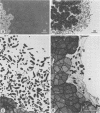Abstract
Methanogenesis from ethanol by defined mixed continuous cultures was studied. Under sulfate-free conditions, a Desulfovibrio strain was used as the ethanol-degrading species producing acetic acid and hydrogen. In a two-membered mutualistic coculture, the hydrogen was converted to methane by a Methanobacterium sp. and pH was maintained at neutrality by the addition of alkali. Introduction of a third species, the acetate-utilizing Methanosarcina mazei, obviated the need for external pH control. Methanogenesis by the co-and triculture was studied at various dilution rates in the steady state. The mutualistic coculture performed like a composite single species, as predicted from the theory of mutualistic interactions. Coupling between the mutualistic coculture and the acetate-utilizing methanogen was less tight. Increasing the dilution rate destabilized the triculture; at low dilution rates, instability was soon recovered, but at higher dilution rates imbalance between the rates of production and removal of acetic acid led to a drop in pH. Flocs formed in the triculture. An annulus of the Methanobacterium sp. and Desulfovibrio sp. was retained around the Methanosarcina sp. by strands of material probably derived from the Methanosarcina sp.
Full text
PDF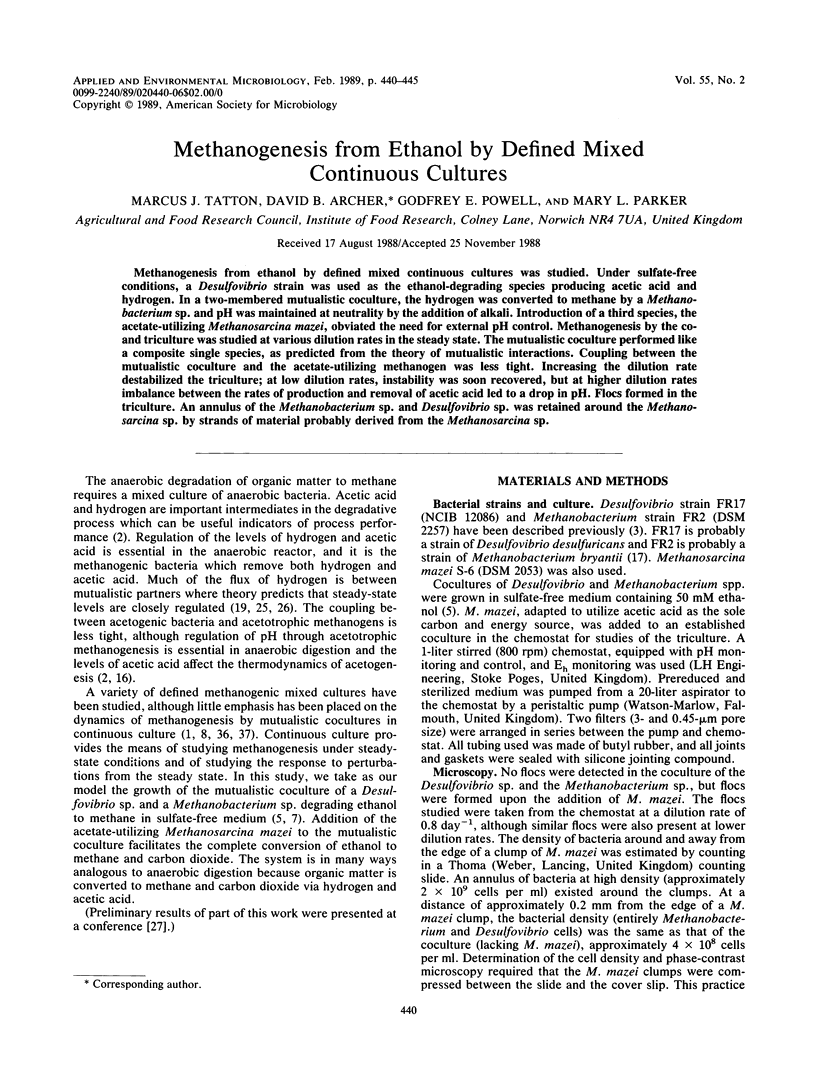
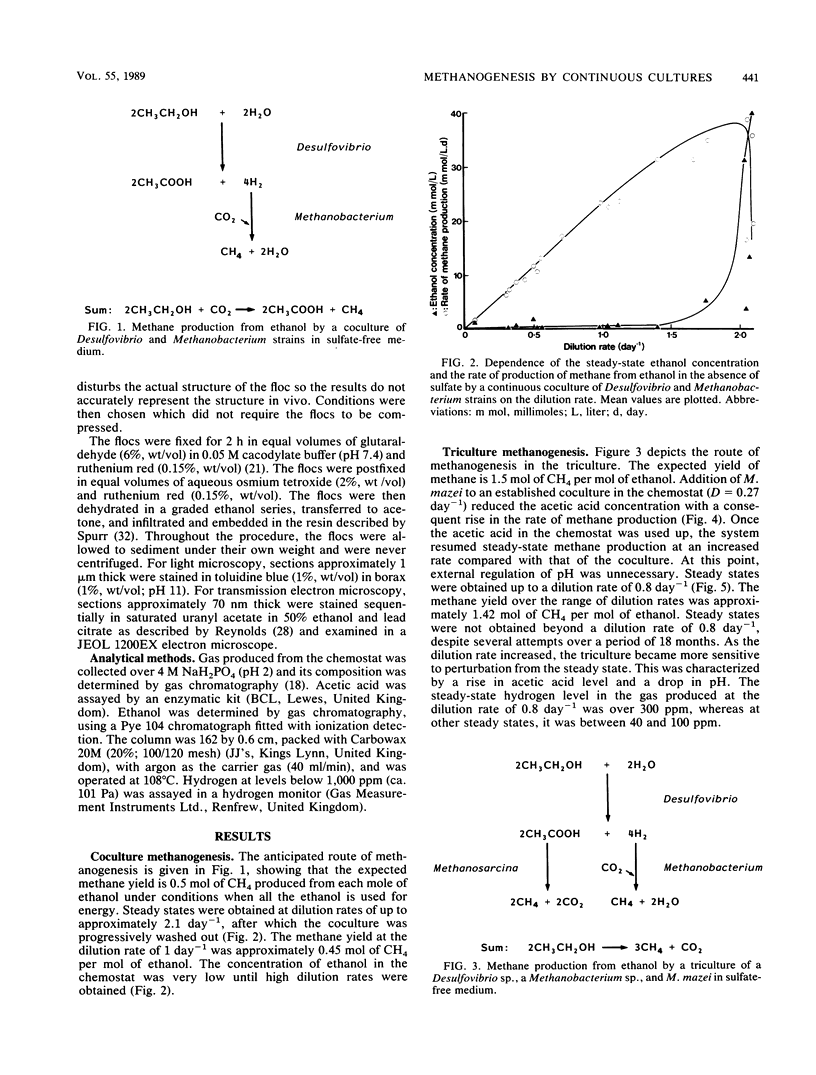
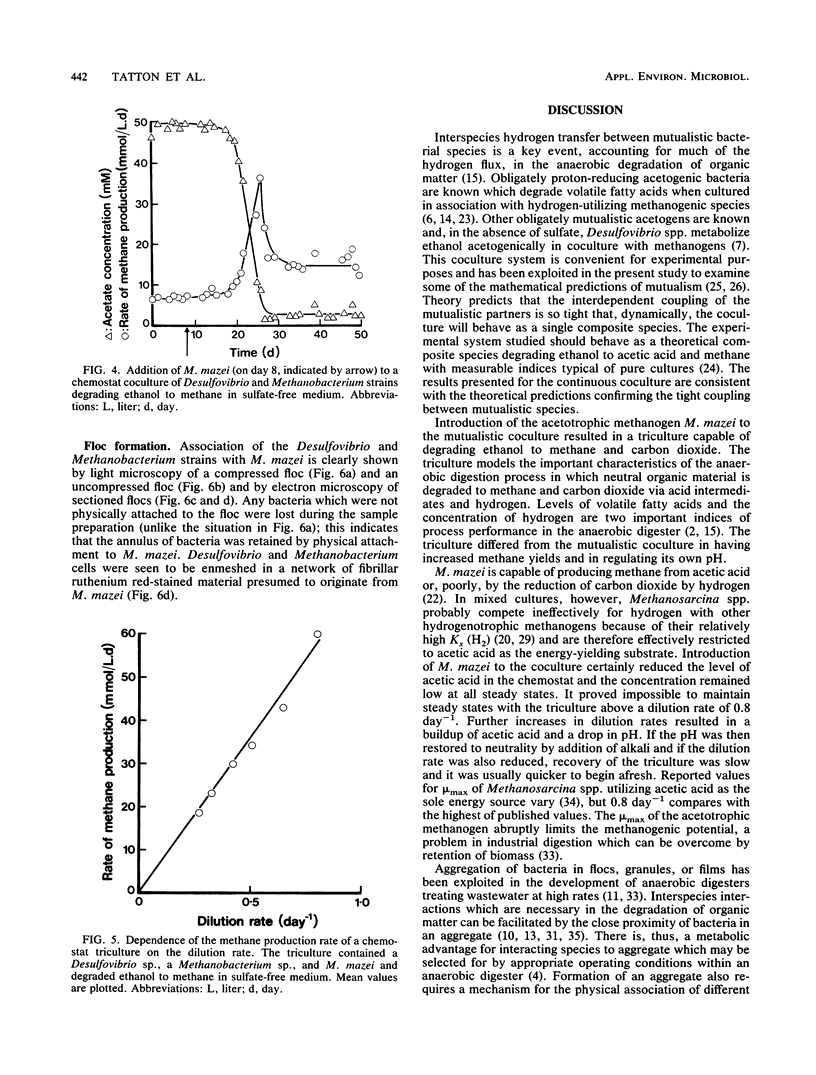
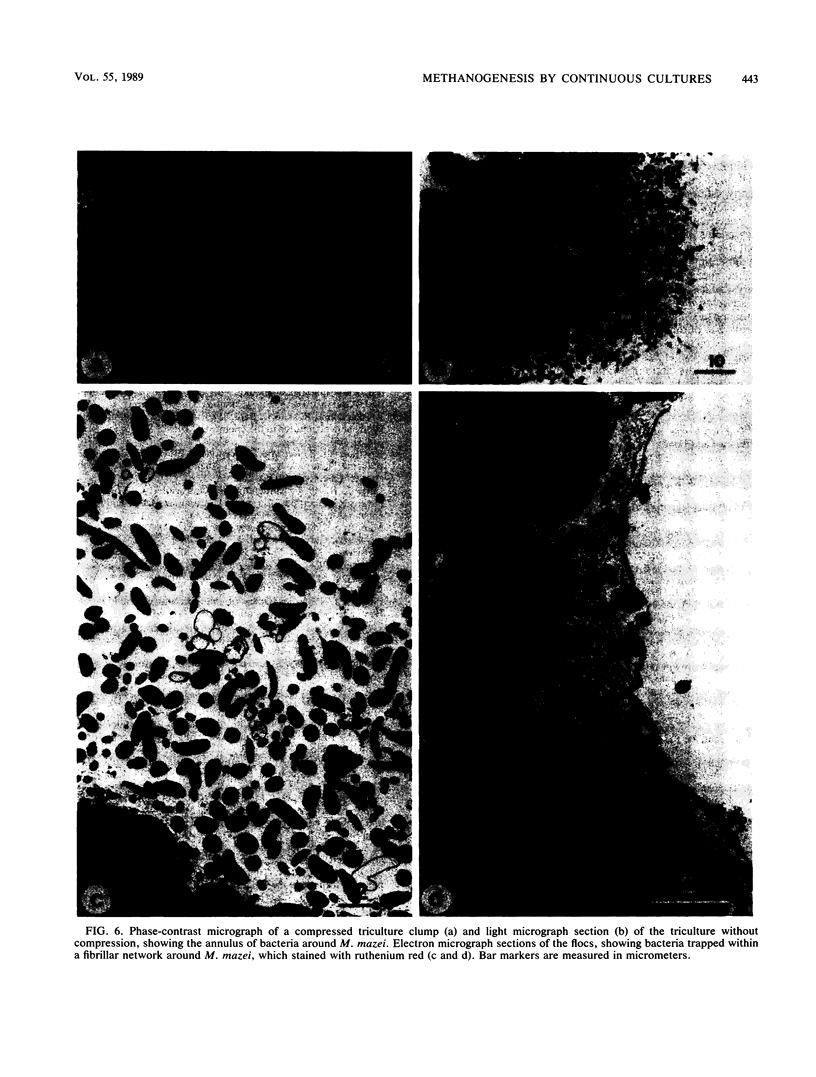
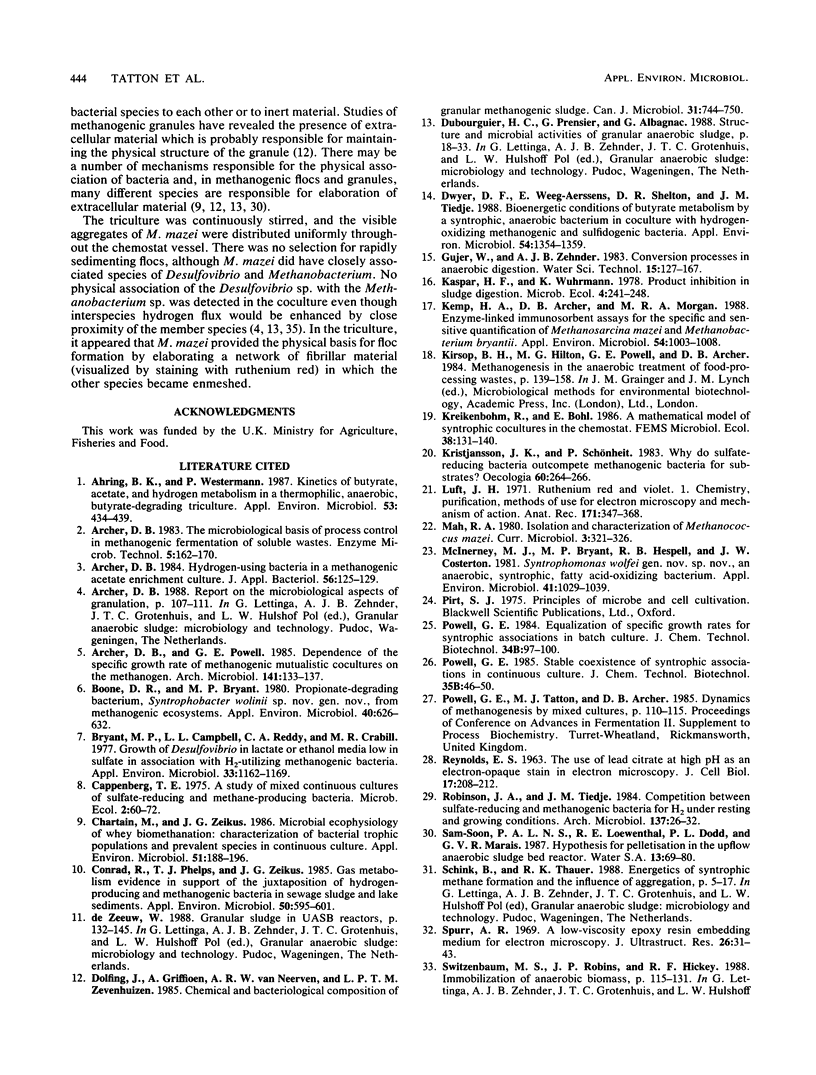

Images in this article
Selected References
These references are in PubMed. This may not be the complete list of references from this article.
- Ahring B. K., Westermann P. Kinetics of butyrate, acetate, and hydrogen metabolism in a thermophilic, anaerobic, butyrate-degrading triculture. Appl Environ Microbiol. 1987 Feb;53(2):434–439. doi: 10.1128/aem.53.2.434-439.1987. [DOI] [PMC free article] [PubMed] [Google Scholar]
- Archer D. B. Hydrogen-using bacteria in a methanogenic acetate enrichment culture. J Appl Bacteriol. 1984 Feb;56(1):125–129. doi: 10.1111/j.1365-2672.1984.tb04703.x. [DOI] [PubMed] [Google Scholar]
- Boone D. R., Bryant M. P. Propionate-Degrading Bacterium, Syntrophobacter wolinii sp. nov. gen. nov., from Methanogenic Ecosystems. Appl Environ Microbiol. 1980 Sep;40(3):626–632. doi: 10.1128/aem.40.3.626-632.1980. [DOI] [PMC free article] [PubMed] [Google Scholar]
- Bryant M. P., Campbell L. L., Reddy C. A., Crabill M. R. Growth of desulfovibrio in lactate or ethanol media low in sulfate in association with H2-utilizing methanogenic bacteria. Appl Environ Microbiol. 1977 May;33(5):1162–1169. doi: 10.1128/aem.33.5.1162-1169.1977. [DOI] [PMC free article] [PubMed] [Google Scholar]
- Chartrain M., Zeikus J. G. Microbial ecophysiology of whey biomethanation: characterization of bacterial trophic populations and prevalent species in continuous culture. Appl Environ Microbiol. 1986 Jan;51(1):188–196. doi: 10.1128/aem.51.1.188-196.1986. [DOI] [PMC free article] [PubMed] [Google Scholar]
- Conrad R., Phelps T. J., Zeikus J. G. Gas metabolism evidence in support of the juxtaposition of hydrogen-producing and methanogenic bacteria in sewage sludge and lake sediments. Appl Environ Microbiol. 1985 Sep;50(3):595–601. doi: 10.1128/aem.50.3.595-601.1985. [DOI] [PMC free article] [PubMed] [Google Scholar]
- Dwyer D. F., Weeg-Aerssens E., Shelton D. R., Tiedje J. M. Bioenergetic conditions of butyrate metabolism by a syntrophic, anaerobic bacterium in coculture with hydrogen-oxidizing methanogenic and sulfidogenic bacteria. Appl Environ Microbiol. 1988 Jun;54(6):1354–1359. doi: 10.1128/aem.54.6.1354-1359.1988. [DOI] [PMC free article] [PubMed] [Google Scholar]
- Kemp H. A., Archer D. B., Morgan M. R. Enzyme-Linked Immunosorbent Assays for the Specific and Sensitive Quantification of Methanosarcina mazei and Methanobacterium bryantii. Appl Environ Microbiol. 1988 Apr;54(4):1003–1008. doi: 10.1128/aem.54.4.1003-1008.1988. [DOI] [PMC free article] [PubMed] [Google Scholar]
- Luft J. H. Ruthenium red and violet. I. Chemistry, purification, methods of use for electron microscopy and mechanism of action. Anat Rec. 1971 Nov;171(3):347–368. doi: 10.1002/ar.1091710302. [DOI] [PubMed] [Google Scholar]
- McInerney M. J., Bryant M. P., Hespell R. B., Costerton J. W. Syntrophomonas wolfei gen. nov. sp. nov., an Anaerobic, Syntrophic, Fatty Acid-Oxidizing Bacterium. Appl Environ Microbiol. 1981 Apr;41(4):1029–1039. doi: 10.1128/aem.41.4.1029-1039.1981. [DOI] [PMC free article] [PubMed] [Google Scholar]
- REYNOLDS E. S. The use of lead citrate at high pH as an electron-opaque stain in electron microscopy. J Cell Biol. 1963 Apr;17:208–212. doi: 10.1083/jcb.17.1.208. [DOI] [PMC free article] [PubMed] [Google Scholar]
- Spurr A. R. A low-viscosity epoxy resin embedding medium for electron microscopy. J Ultrastruct Res. 1969 Jan;26(1):31–43. doi: 10.1016/s0022-5320(69)90033-1. [DOI] [PubMed] [Google Scholar]
- Thiele Jurgen H., Chartrain M., Zeikus J. Gregory. Control of Interspecies Electron Flow during Anaerobic Digestion: Role of Floc Formation in Syntrophic Methanogenesis. Appl Environ Microbiol. 1988 Jan;54(1):10–19. doi: 10.1128/aem.54.1.10-19.1988. [DOI] [PMC free article] [PubMed] [Google Scholar]
- Traore A. S., Fardeau M. L., Hatchikian C. E., Le Gall J., Belaich J. P. Energetics of Growth of a Defined Mixed Culture of Desulfovibrio vulgaris and Methanosarcina barkeri: Interspecies Hydrogen Transfer in Batch and Continuous Cultures. Appl Environ Microbiol. 1983 Nov;46(5):1152–1156. doi: 10.1128/aem.46.5.1152-1156.1983. [DOI] [PMC free article] [PubMed] [Google Scholar]
- Winter J. U., Wolfe R. S. Methane formation from fructose by syntrophic associations of Acetobacterium woodii and different strains of methanogens. Arch Microbiol. 1980 Jan;124(1):73–79. doi: 10.1007/BF00407031. [DOI] [PubMed] [Google Scholar]



